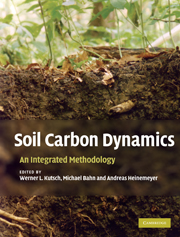Book contents
- Frontmatter
- Contents
- List of Contributors
- Preface
- Editorial Acknowledgements
- 1 Soil carbon relations: an overview
- 2 Field measurements of soil respiration: principles and constraints, potentials and limitations of different methods
- 3 Experimental design: scaling up in time and space, and its statistical considerations
- 4 Determination of soil carbon stocks and changes
- 5 Litter decomposition: concepts, methods and future perspectives
- 6 Characterization of soil organic matter
- 7 Respiration from roots and the mycorrhizosphere
- 8 Separating autotrophic and heterotrophic components of soil respiration: lessons learned from trenching and related root-exclusion experiments
- 9 Measuring soil microbial parameters relevant for soil carbon fluxes
- 10 Trophic interactions and their implications for soil carbon fluxes
- 11 Semi-empirical modelling of the response of soil respiration to environmental factors in laboratory and field conditions
- 12 Modelling soil carbon dynamics
- 13 The role of soils in the Kyoto Protocol
- 14 Synthesis: emerging issues and challenges for an integrated understanding of soil carbon fluxes
- 15 Appendix: Towards a standardized protocol for the measurement of soil CO2 efflux
- Index
- References
11 - Semi-empirical modelling of the response of soil respiration to environmental factors in laboratory and field conditions
Published online by Cambridge University Press: 11 May 2010
- Frontmatter
- Contents
- List of Contributors
- Preface
- Editorial Acknowledgements
- 1 Soil carbon relations: an overview
- 2 Field measurements of soil respiration: principles and constraints, potentials and limitations of different methods
- 3 Experimental design: scaling up in time and space, and its statistical considerations
- 4 Determination of soil carbon stocks and changes
- 5 Litter decomposition: concepts, methods and future perspectives
- 6 Characterization of soil organic matter
- 7 Respiration from roots and the mycorrhizosphere
- 8 Separating autotrophic and heterotrophic components of soil respiration: lessons learned from trenching and related root-exclusion experiments
- 9 Measuring soil microbial parameters relevant for soil carbon fluxes
- 10 Trophic interactions and their implications for soil carbon fluxes
- 11 Semi-empirical modelling of the response of soil respiration to environmental factors in laboratory and field conditions
- 12 Modelling soil carbon dynamics
- 13 The role of soils in the Kyoto Protocol
- 14 Synthesis: emerging issues and challenges for an integrated understanding of soil carbon fluxes
- 15 Appendix: Towards a standardized protocol for the measurement of soil CO2 efflux
- Index
- References
Summary
INTRODUCTION
Soil respiration, globally 68–80 Pg C y−1, represents the second largest carbon flux between ecosystems and the atmosphere (Schimel et al., 1996; Raich et al., 2002). This is more than ten times the current rate of fossil fuel combustion and indicates that each year around 10% of the atmosphere's CO2 cycles through the soil. Thus, even a small change in soil respiration could significantly intensify – or mitigate – current atmospheric increases of CO2, with potential feedbacks to climate change. Despite this global significance and the considerable scientific commitment to its study over the last decades, there is still limited comprehensive understanding of the factors controlling temporal and across-ecosystem variability of soil respiration.
This understanding is largely hampered by the fact that studies are often conducted and compared at different temporal and spatial scales that are not compatible. Since, particularly in large-scale studies, factors influencing soil respiration often correlate with each other, responses of soil respiration to those factors are confounded and only apparent relationships are obtained.
For the purpose of this chapter, methods (and their associated problems) for analyzing soil respiration data from different scales are reviewed and jointly interpreted with emphasis on the temperature dependence of soil respiration.
MODELLING SOIL RESPIRATION: AN OVERVIEW
General modelling approaches
Soil respiration – defined as the CO2 efflux from the soil surface – originates from the metabolic activity of roots (autotrophic respiration), micro-organisms (bacteria, actinomycetes and fungi) and soil meso- and macro-fauna (heterotrophic respiration).
Information
- Type
- Chapter
- Information
- Soil Carbon DynamicsAn Integrated Methodology, pp. 207 - 220Publisher: Cambridge University PressPrint publication year: 2010
References
Accessibility standard: Unknown
Why this information is here
This section outlines the accessibility features of this content - including support for screen readers, full keyboard navigation and high-contrast display options. This may not be relevant for you.Accessibility Information
- 2
- Cited by
